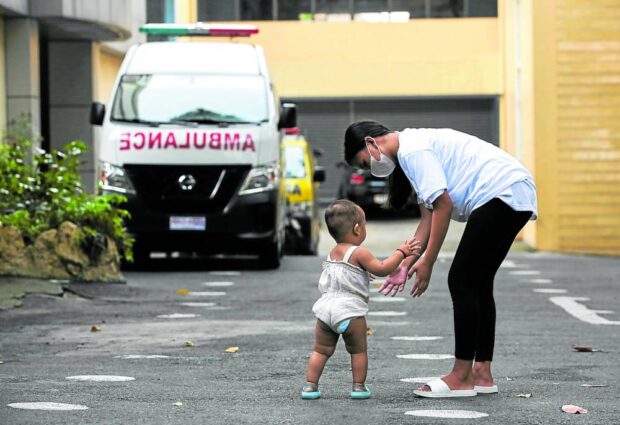Can new law help tackle PH teen pregnancy emergency?
Can new law help tackle PH teen pregnancy emergency? Inquirer.net


Teen Pregnancy Prevention Bill in the Philippines

A new bill that could be a game changer in the battle against teen pregnancies in the Philippines is inching through Congress, with activists hoping it could galvanize a wider campaign to tackle this “national social emergency.”
The Adolescent Pregnancy Prevention Bill
The Adolescent Pregnancy Prevention Bill, which was passed by the House in September and has moved to the Senate, aims to expand access to sexual and reproductive health services, like contraception, in this mainly Catholic country where early pregnancies, even among girls as young as 10, are rife and where the age of consent was only raised from 12 to 16 last year.
Support for the Bill
The Philippine Legislators’ Committee on Population and Development, one of the groups campaigning for the bill, said it was only two steps away from a vote in the Senate. “We are hopeful that the senators will find the time to deliberate on the measure and see not only the bill’s merit … but also its urgency,” Rom Dongeto, the group’s executive director, said in a statement.
Discordance in Current Laws
If the bill is passed, it would end the contradiction inherent in the fact that the legal age of consent for sexual relations is 16 but that written parental consent is needed for children aged under 18 to access contraceptives. This discordance, a lack of sufficient information on sexual and reproductive health, and the silencing effect of social stigma have fused to foster high rates of teenage pregnancies, health experts say.
Importance of Contraceptive Access
“When girls are already sexually active, abstinence is not enough. They need to have access to contraceptives, which is another legal barrier in the country,” said Leila Joudane, United Nations Population Fund (UNFPA) Philippines representative. “This is why I’m happy to see in the Senate and the House, there is the adolescent pregnancy prevention bill that is now being discussed, so that adolescents can have access to contraception, at least when they are 15 and over,” she told Thomson Reuters Foundation.
Key Provisions of the Bill
The bill recognizes the “evolving capacities of children” to make their own informed decisions when it comes to their health and sexuality. It calls for children 15 and under, who are sexually active or pregnant or who have begun childbearing, to have full access to reproductive health services without parental consent. All boys and girls from 15 to 18 should also be allowed the same, it says.
Teen Pregnancy as a National Social Emergency
In 2019, the government declared pregnancies among 10- to 14-year-olds a national social emergency. The following year, UNFPA quoted World Bank data showing that the Philippines had 47 births annually per 1,000 women age 15 to 19, equating to more than 500 Filipino adolescent girls getting pregnant and giving birth every day. And although there was a drop in teenage pregnancy among girls in that age group, from 8.6 percent in 2017 to 5.4 percent last year, Joudane says early childbearing is a “vicious cycle” and the issue is far from being resolved, with rates remaining stubbornly high among girls age 10 to 14.
Impact of Teen Pregnancy
The costs of teen pregnancies, in a country where around 30 percent of the population is under 15 and where recent estimates say one in six girls gets married before she is 18, ripple out from the individual to affect communities and the economy as well. That’s why its supporters say the bill is important. “It will save young girls from the clutches of maternal death, unemployment, poverty, improve their future and reinforce their self-esteem,” Edcel Lagman, one of the authors of the bill, said in a statement after it was passed by the House.
Predictor of Poverty
Lagman had said that early pregnancy is one of the most reliable predictors of future poverty. This is because girls who become pregnant often fail to finish basic education and become economically vulnerable, entrenching intergenerational poverty. The estimated net effect of early childbearing, taking into account lost opportunities and foregone earnings, is around P33 billion annually, according to a 2016 study commissioned by UNFPA. Adolescent pregnancy is also a major reason why the Philippines’ female labor force rate is one of the lowest in Southeast Asia.
Challenges and Solutions
The bill may help turn the tide against teen pregnancies, but activists acknowledge the challenge goes deeper. Changing mindsets will also be critical, as will expanding access to adolescent-friendly sexual health services. “We need to address social norms and the legal barriers to sexual reproductive health services, and family planning programs need to be accessible and available everywhere,” Joudane said. “For the 10 to 14 (year-olds), we need to educate parents so that they can give consent to girls to access contraceptives. It’s important to work on social norms and also the legal barriers.”
Efforts to Tackle Teen Pregnancy
Last year UNFPA, which wants to see zero teenage pregnancies by 2030, launched a $1-million campaign alongside the Department of Health (DOH), World Health Organization and Korea International Cooperation Agency to support health workers. The project is designed to help 275,000 adolescents in 20 towns in Samar and Southern Leyte—two poor and typhoon-prone provinces in the Eastern Visayas.
Importance of Adolescent-Friendly Facilities
Eva Estonillo, a midwife and planning officer on adolescent health in the municipality of Marabut in Samar, helped turn her health unit into what the DOH calls an “adolescent-friendly facility,” offering peer consultations and information on maternal care and family planning. “Before our facility became adolescent-friendly, young people would often shy away from seeking help, or they would be sent away by rural health staff,” she said. “Because adolescents are now encouraged to seek help from our facility, I noticed that more teen mothers have become interested in our family planning services.” This too is important as many teens have a rapid series of pregnancies after an early first birth.
Conclusion
The availability of such services could benefit people like Sandra, a resident of Marabut, who had her first child in July last year. “I want to
SDGs, Targets, and Indicators
-
SDG 3: Good Health and Well-being
- Target 3.7: By 2030, ensure universal access to sexual and reproductive health-care services, including for family planning, information and education, and the integration of reproductive health into national strategies and programs.
- Indicator 3.7.1: Proportion of women of reproductive age (aged 15-49 years) who have their need for family planning satisfied with modern methods.
-
SDG 4: Quality Education
- Target 4.1: By 2030, ensure that all girls and boys complete free, equitable, and quality primary and secondary education leading to relevant and effective learning outcomes.
- Indicator 4.1.1: Proportion of children and young people (a) in grades 2/3; (b) at the end of primary; and (c) at the end of lower secondary achieving at least a minimum proficiency level in (i) reading and (ii) mathematics, by sex.
-
SDG 5: Gender Equality
- Target 5.6: Ensure universal access to sexual and reproductive health and reproductive rights as agreed in accordance with the Program of Action of the International Conference on Population and Development and the Beijing Platform for Action and the outcome documents of their review conferences.
- Indicator 5.6.1: Proportion of women aged 15-49 years who make their own informed decisions regarding sexual relations, contraceptive use, and reproductive health care.
-
SDG 8: Decent Work and Economic Growth
- Target 8.5: By 2030, achieve full and productive employment and decent work for all women and men, including for young people and persons with disabilities, and equal pay for work of equal value.
- Indicator 8.5.1: Average hourly earnings of female and male employees, by occupation, age group, and persons with disabilities.
-
SDG 10: Reduced Inequalities
- Target 10.2: By 2030, empower and promote the social, economic, and political inclusion of all, irrespective of age, sex, disability, race, ethnicity, origin, religion, or economic or other status.
- Indicator 10.2.1: Proportion of people living below 50 percent of median income, by age, sex, and persons with disabilities.
Table: SDGs, Targets, and Indicators
| SDGs | Targets | Indicators |
|---|---|---|
| SDG 3: Good Health and Well-being | Target 3.7: By 2030, ensure universal access to sexual and reproductive health-care services, including for family planning, information and education, and the integration of reproductive health into national strategies and programs. | Indicator 3.7.1: Proportion of women of reproductive age (aged 15-49 years) who have their need for family planning satisfied with modern methods. |
| SDG 4: Quality Education | Target 4.1: By 2030, ensure that all girls and boys complete free, equitable, and quality primary and secondary education leading to relevant and effective learning outcomes. | Indicator 4.1.1: Proportion of children and young people (a) in grades 2/3; (b) at the end of primary; and (c) at the end of lower secondary achieving at least a minimum proficiency level in (i) reading and (ii) mathematics, by sex. |
| SDG 5: Gender Equality | Target 5.6: Ensure universal access to sexual and reproductive health and reproductive rights as agreed in accordance with the Program of Action of the International Conference on Population and Development and the Beijing Platform for Action and the outcome documents of their review conferences. | Indicator 5.6.1: Proportion of women aged 15-49 years who make their own informed decisions regarding sexual relations, contraceptive use, and reproductive health care. |
| SDG 8: Decent Work and Economic Growth | Target 8.5: By 2030, achieve full and productive employment and decent work for all women and men, including for young people and persons with disabilities, and equal pay for work of equal value. | Indicator 8.5.1: Average hourly earnings of female and male employees, by occupation, age group, and persons with disabilities. |
| SDG 10: Reduced Inequalities | Target 10.2: By 2030, empower and promote the social, economic, and political inclusion of all, irrespective of age, sex, disability, race, ethnicity, origin, religion, or economic or other status. | Indicator 10.2.1: Proportion of people living below 50 percent of median income, by age, sex, and persons with disabilities. |
Behold! This splendid article springs forth from the wellspring of knowledge, shaped by a wondrous proprietary AI technology that delved into a vast ocean of data, illuminating the path towards the Sustainable Development Goals. Remember that all rights are reserved by SDG Investors LLC, empowering us to champion progress together.
Source: newsinfo.inquirer.net

Join us, as fellow seekers of change, on a transformative journey at https://sdgtalks.ai/welcome, where you can become a member and actively contribute to shaping a brighter future.







